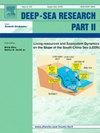查理-吉布斯断裂带垂直壁上海绵和冷水珊瑚栖息地选择和生态位分化的精细尺度变异性
IF 3
3区 地球科学
Q2 OCEANOGRAPHY
Deep-sea Research Part Ii-topical Studies in Oceanography
Pub Date : 2025-02-01
DOI:10.1016/j.dsr2.2024.105437
引用次数: 0
摘要
深海垂直壁的特点是流体动力学增强,基材坚硬,特别适合悬浮捕食者,包括脆弱的海洋生态系统(VMEs)指标分类群,如冷水珊瑚(CWC)和海绵。这些物种增加了非生物背景的复杂性和营养资源的保留,增加了其他生物栖息地的可用性。虽然垂直岩壁的某些区域存在高密度的vme,但其他区域大多是裸露的岩石。然而,尽管它们具有重要的生态意义,但在细尺度(1 m以下)垂直壁上有利于CWC和海绵存在的生境特征仍然知之甚少。由于技术限制,在深海生境中很少量化精细尺度地形变量(如方位、曲率、垂直度、粗糙度、坡度)。这些地形变量可以代表群落结构因素(例如,传递食物的水动力、沉积速率)的代理,这对了解VME指示物种的栖息地选择很重要。本文研究了查理-吉布斯断裂带垂直壁上CWC和海绵的精细尺度生境选择和生态位分化。基于远程操作车辆(ROV)视频(深度为1060-1901 m),采用动态结构摄影测量技术创建了三个垂直墙的高分辨率3D模型。三维模型被用来在精细尺度上推导地形变量,并对珊瑚和海绵进行地理标记。利用生态位因子分析,我们发现珊瑚和海绵选择的栖息地特征与平均可用栖息地有显著差异。所研究的珊瑚和海绵显示出较大或完整的生态位分配。螺杆苋属植物与Geodia属植物和球形海绵的生态位完全分离,与Hertwigia属植物的生态位部分分离;相反,近亲海绵的生态位更相似。本研究有助于我们进一步了解这些生物之间物种共存的过程以及影响VME指示物种在陡峭水下景观中栖息地偏好的因素。本文章由计算机程序翻译,如有差异,请以英文原文为准。
Fine-scale variability in habitat selection and niche differentiation between sponges and cold-water corals on vertical walls of the Charlie-Gibbs Fracture Zone
Deep-sea vertical walls are characterized by enhanced hydrodynamics and hard substrates, making them particularly suitable habitats for suspension feeders, including vulnerable marine ecosystems (VMEs) indicator taxa, like cold-water corals (CWC) and sponges. These species enhance the complexity of the abiotic background and the retention of trophic resources increasing habitat availability for other organisms. While some areas of vertical walls present a high density of VMEs, others are mostly bare rock. However, the habitat characteristics that favor the presence of CWC and sponges within vertical walls at a fine-scale (under 1 m) are still poorly understood despite their ecological importance. Owing to technological limitations, fine-scale terrain variables (e.g., orientation, curvature, verticality, roughness, slope) have seldom been quantified in deep-sea habitats. These terrain variables can represent proxies of community structuring factors (e.g., hydrodynamics conveying food, sedimentation rates) important to understand habitat selection of VME indicator species. In this study, we investigate the fine-scale habitat selection and niche differentiation of CWC and sponges on vertical walls of the Charlie-Gibbs Fracture Zone. Structure-from-motion photogrammetry was employed to create high-resolution 3D models of three vertical walls based on remotely operated vehicle (ROV) videos (at 1060-1901 m depth). The 3D models were used to derive terrain variables at fine-scale and geotag corals and sponges. Using ecological niche factor analysis, we reveal that corals and sponges selected habitat features that significantly differ from the average habitat available. The corals and sponges studied showed large or complete niche partitioning. Solenosmilia sp. had total niche separation with Geodia spp. and globular sponges and partial separation with Hertwigia spp., while Scleralcyonacea showed partial niche separation with Geodia spp. and globular sponges. Conversely, the niches of closely related sponges were more similar. This research advances our understanding of the processes enabling species co-existence among these organisms and the factors influencing habitat preferences of VME indicator species on steep underwater landscapes.
求助全文
通过发布文献求助,成功后即可免费获取论文全文。
去求助
来源期刊
CiteScore
6.40
自引率
16.70%
发文量
115
审稿时长
3 months
期刊介绍:
Deep-Sea Research Part II: Topical Studies in Oceanography publishes topical issues from the many international and interdisciplinary projects which are undertaken in oceanography. Besides these special issues from projects, the journal publishes collections of papers presented at conferences. The special issues regularly have electronic annexes of non-text material (numerical data, images, images, video, etc.) which are published with the special issues in ScienceDirect. Deep-Sea Research Part II was split off as a separate journal devoted to topical issues in 1993. Its companion journal Deep-Sea Research Part I: Oceanographic Research Papers, publishes the regular research papers in this area.

 求助内容:
求助内容: 应助结果提醒方式:
应助结果提醒方式:


